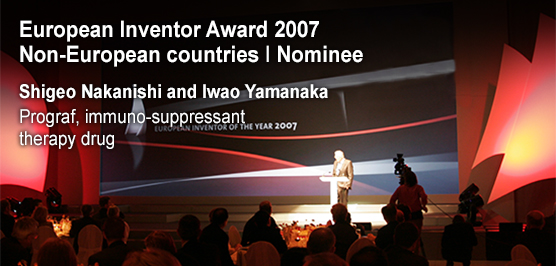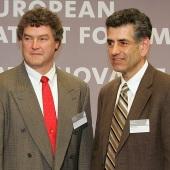Shigeo Nakanishi, Iwao Yamanaka
Prograf, immuno-suppressant therapy drug
In This Vein
A strong immune system is typically a good thing. But not when it comes to organ transplants. In some cases, the human body's immune system can flat out reject a transplanted organ, treating it as an invader and attacking it just as it would foreign bacteria.
This very problem used to be the ultimate barrier to successful transplants, but over the last thirty years, numerous developments have been marketed to tackle this issue and to essentially lower the body's immune system and thus the probability of organ rejection.
A key step forward in immuno-suppression drugs came in the early 1980s with the use of a calcineurin inhibitor known as Cyclosporine. Its discovery allowed for a wider variety of organs to be transplanted and opened up the procedure to a greater number of people.
But cyclosporin's dominance of the calcineurin inhibitor market waned in the 1990s - thanks to Japanese inventor Shigeo Nakanishi and his colleague Iwao Yamanaka.
Helping thousands around the world
Nakanishi and Yamanaka's patent was for the intravenous injection of the drug Tacrolimus, marketed as Prograf (the drug can also be used in capsule form); they developed the solution at Japan-based Fujisawa Pharmaceutical.
The development marked a breakthrough because it helped bridge the very crucial phase after transplant surgery is performed - a volatile time period during which Prograf can only be administered through an around-the-clock IV infusion. Only later can patients move to the capsule-based form.
Prograf's overall track record has been nothing short of impressive: since gaining approval in 1994 for use in liver transplants and for kidney transplants three years later, it has helped more than 100,000 people in over 70 countries, fast becoming the global standard drug for organ transplant.
To a large extent, that has to do with its very high toleration rate among patients. Another reason is its unique characteristics, some of which help speed up the wound's healing process, something particularly important when dealing with large wound cases (for example, liver transplants). Currently, Prograf is used in over 80 percent of new kidney transplants and over 90 percent of liver transplants in the United States.
Meanwhile, new uses for the drug are also being explored, and in 2006, Prograf was granted approval by the US-based Food and Drug Administration for use in heart transplants.
Pulling away
Given that emergence and its vast possibilities, it comes as no surprise that Prograf now seems to be taking over for good from cyclosporin as the No. 1 calcineurin inhibitor.
A United Network for Organ Sharing 2005 report identifies both Prograf and rival Neoral (cyclosporine microemulsion) as the drugs providing the "foundation for maintenance immunosuppression regimens," but goes on to say that over the last few years, the use of Cyclosporine has been giving way significantly to the use of Prograf.
But looking at Nakanishi and Yamanaka‘s invention on a basic, human level, its success has one simple reason: the very fundamental - and crucial - need to perform transplants in the most successful and patient-friendly manner possible. And that's precisely what their discovery helps achieve.
How it works
As a therapeutic alternative to cyclosporin, Prograf represents a cornerstone of immuno-suppressive therapy in organ transplant recipients.
Originally called Tacrolimus (sometimes referred to as FK-506), it is a calcineurin inhibitor that helps lower the human body's immune system, thus stopping it from rejecting a new organ.
Prograf works by binding to an immunophilin (an intracellular protein). The complex then binds to calcineurin and inhibits phosphatase activity. In doing this, it prevents the cells moving from the dormant stage to the G1 growth phase.
The drug comes in two forms: as a capsule and as an intravenous injection, the latter method developed by Nakanishi and Yamanaka. Directly after the transplant surgery, the drug is administered to the patient through a needle placed in the vein. It is only later, after this crucial stage, that the patient is ready to use the drug in capsule form.
Contact
European Inventor Award and Young Inventors Prize queries:
european-inventor@epo.org Subscribe to the European Inventor Award newsletterMedia-related queries:
Contact our Press team#InventorAward #YoungInventors



